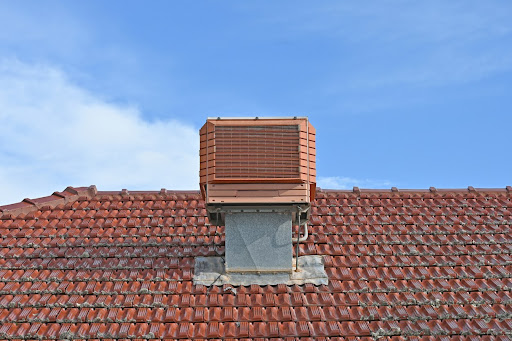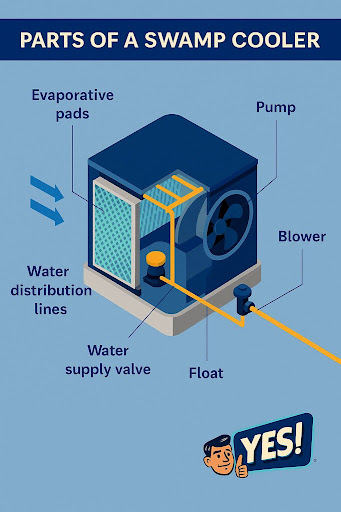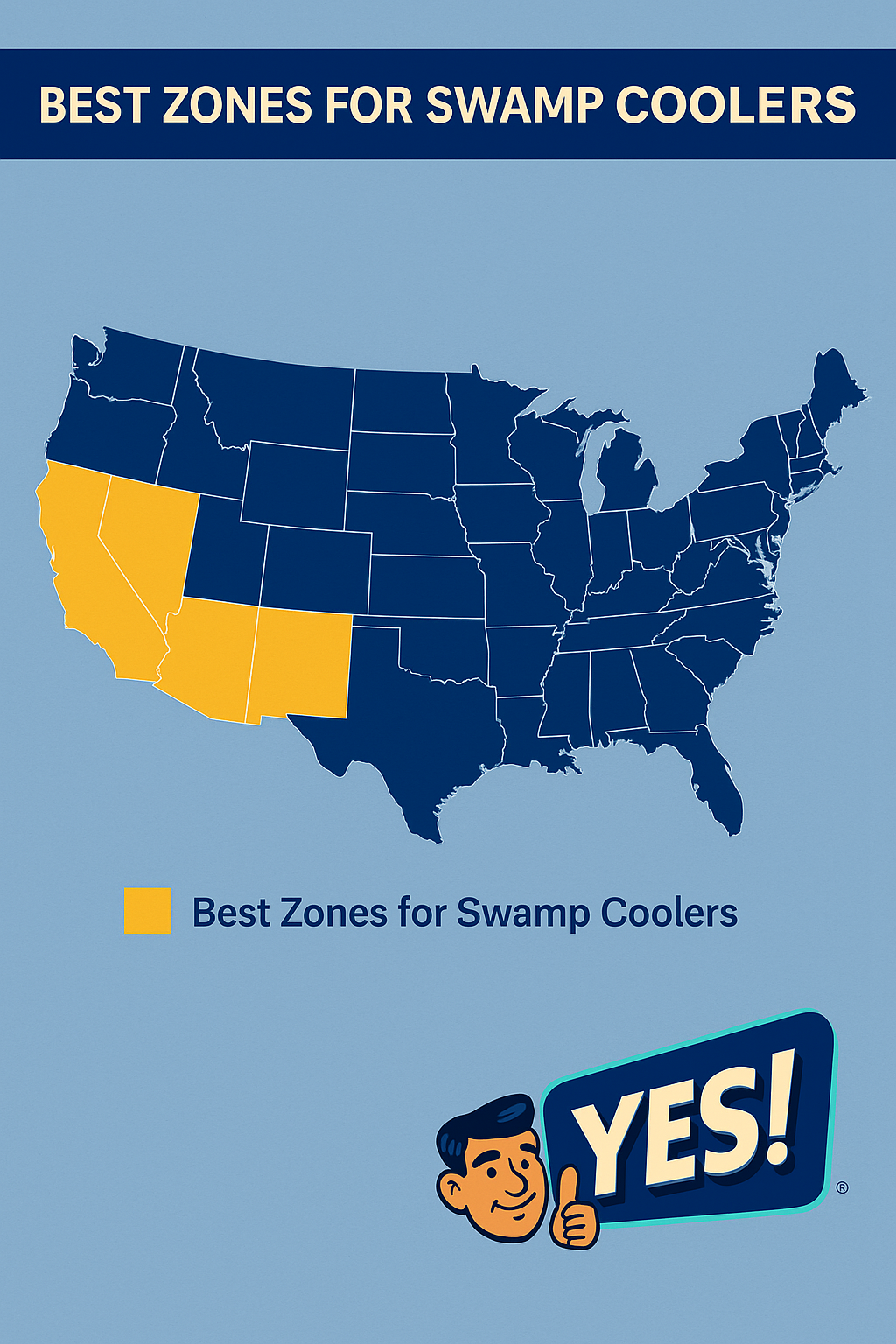Are Swamp Coolers Effective & Energy-Efficient?
If you’re weighing your cooling options for your home or rental property, you’ve likely come across swamp coolers (also called evaporative coolers). With promises of lower energy bills and eco-friendliness, they can seem like the perfect choice—especially in dry climates.
But are swamp coolers effective? Furthermore, are swamp coolers energy-efficient enough to replace modern AC systems?
At YES!, we help Utah and Nevada homeowners make informed decisions about home comfort. In this guide, we’ll break down how swamp coolers work, compare them to air conditioners, and explore their pros and cons.
What Is a Swamp Cooler?

A swamp cooler is a type of air cooling system that uses evaporation to lower temperatures.
-
It pulls hot, dry air from outside the unit.
-
The hot air passes over water-saturated pads.
-
Once cool, the air blows into your home.
This process can be very effective if the humidity is low enough.
Thinking about installing a swamp cooler or air conditioner? Call 844-216-9300 for expert advice and installation services.
How Swamp Coolers Work
How do you use a swamp cooler? We’ll answer that by explaining how its parts and processes work together. A swamp cooler operates using six main parts:
-
Evaporative pads: These water-absorbing pads line the inside of the swamp cooler to keep the air clean and cool.
-
Water distribution lines: These tubes deliver water from the pump to the evaporative pads, keeping them continuously wet.
-
Water supply valve: This valve connects the cooler to your home’s water source, typically via a copper line.
-
Pump: The pump circulates water from the cooler’s reservoir to the pads through the distribution lines.
-
Float: This device rises to the top of the water in the swamp cooler to shut off the supply valve when water levels get too high.
-
Blower: The blower fan pulls hot air into the unit, then pushes the newly cooled air through your home’s ductwork or directly into a room.

These six parts work together in four steps:
-
Water is drawn in through the supply valve and fills the base of the swamp cooler.
-
The pump sends water to the evaporative pads, soaking them.
-
Warm air is pulled in from outside and drawn through the wet pads, where evaporation naturally cools it.
-
The blower circulates the now-cooled air throughout your home via ducts or a vent.
Call YES! for Swamp Cooler Maintenance
Swamp Cooler vs. Air Conditioner
Choosing between a swamp cooler and an air conditioner depends on a few key factors: climate, budget, and long-term performance expectations.
Here’s a side-by-side comparison of the two options:
|
Swamp Cooler |
Traditional Air Conditioner |
|
|
Cooling Method |
Evaporation |
Refrigeration |
|
Climate Needs |
Low humidity only |
Any climate |
|
Humidity Control |
Adds moisture |
Removes moisture |
|
Temperature Drop |
Moderate |
Strong and consistent |
|
Energy Use |
Lower |
Moderate to high |
|
Maintenance |
Frequent |
Seasonal |
|
Best For |
Dry, desert regions |
Universal use |
If you’re curious which cooling system suits your home best, contact YES! for a personalized consultation. Our certified experts install air conditioners and swamp coolers while also providing necessary repairs.
How Much Does It Cost to Install a Swamp Cooler?
One of the benefits of a swamp cooler is that it is less expensive upfront than an AC system. A swamp cooler typically costs between $100 and $2500, depending on the size, type, and whether it needs to be installed or is freestanding.
While swamp coolers may appeal to budget-conscious homeowners, they offer less cooling power and limited performance during peak heat. Central air conditioning may be a better long-term investment for those needing reliable, whole-home comfort.
Related Reading: Is it Time to Replace My Air Conditioner?

How Well Do Swamp Coolers Work?
Swamp coolers can effectively lower indoor temperature by up to 15–20°F, depending on outside conditions. This can provide noticeable relief in hot, dry climates like Las Vegas and parts of Utah, especially during early summer or cooler evenings.
However, their cooling power is much more limited than traditional air conditioners, especially during heat waves and high humidity.
Contact YES! for service in Utah
Contact YES! for service in Nevada
Are Swamp Coolers Energy-Efficient?
Yes, technically, swamp coolers are energy-efficient, especially when compared to central air systems. Because they consume ~0.15 kWh while central air conditioners use ~3.5 kWh, swamp coolers use 60 to 75% less electricity than traditional air conditioners.
Cost savings over a year can also be substantial. The average annual operating costs for swamp coolers are $161, compared to $360–$3240 for central air conditioning.
However, real-world performance matters:
-
Swamp coolers are most effective in hot, dry climates with less than 30% humidity.
-
A typical swamp cooler uses 3–15 gallons of water per day.
-
Frequent maintenance (such as pad changes, cleaning, and draining) can reduce convenience and increase effort compared to central AC systems.
Despite the drawbacks, swamp coolers are popular among homeowners who value sustainability and cost-effectiveness.
Your energy-efficient cooling solutions could be right around the corner. Nevada homeowners can contact YES! to explore your options. Reach out here if you’re in Utah.
Swamp Cooler Cons
There are some other downsides to using a swamp cooler. Here are just a few swamp cooler cons to consider before having one installed at home:
-
Roof stains. Swamp coolers installed on top of the house can cause stains to the roof since condensation may occur around the unit. These stains are difficult to remove and are typically permanent.
-
Leaking: Because swamp coolers require water to operate, there is always the risk of leaking, especially when the bottom of a rooftop unit starts rusting. A swamp cooler can even overflow if the float stops working.
-
Fall freeze: Unlike an AC, a swamp cooler must be turned off before the first freeze of the year. Frozen pipes can expand, contract, and even burst, causing serious damage to a home.
-
Threat of injury: Maintaining a swamp cooler can be dangerous, especially if the unit is installed on the roof.
-
Frequent maintenance: Swamp coolers require much more frequent maintenance than air conditioners to effectively cool a home.
-
Noise: Window unit swamp coolers can be very loud and distracting since they sit right inside the room.
-
Uses water resources: Swamp coolers are not recommended for areas with water restrictions or droughts since they require a constant water source to work properly.
Do you have signs of a cooling emergency? Our emergency services are available 24/7 to keep you comfortable and safe when it’s hot outside.
Choose a Swamp Cooler Alternative
While there are some benefits of a swamp cooler, especially in dry climates, the reality is that they’re not a one-size-fits-all solution. A swamp cooler may not provide the consistent comfort or long-term value you’re looking for if you're located in Utah or Nevada, where the climate can vary.
Instead, consider upgrading to a central air conditioning system—a more powerful, reliable, and energy-conscious alternative. For additional information on HVAC system upgrades, call our team and speak with a YES! technician today.
